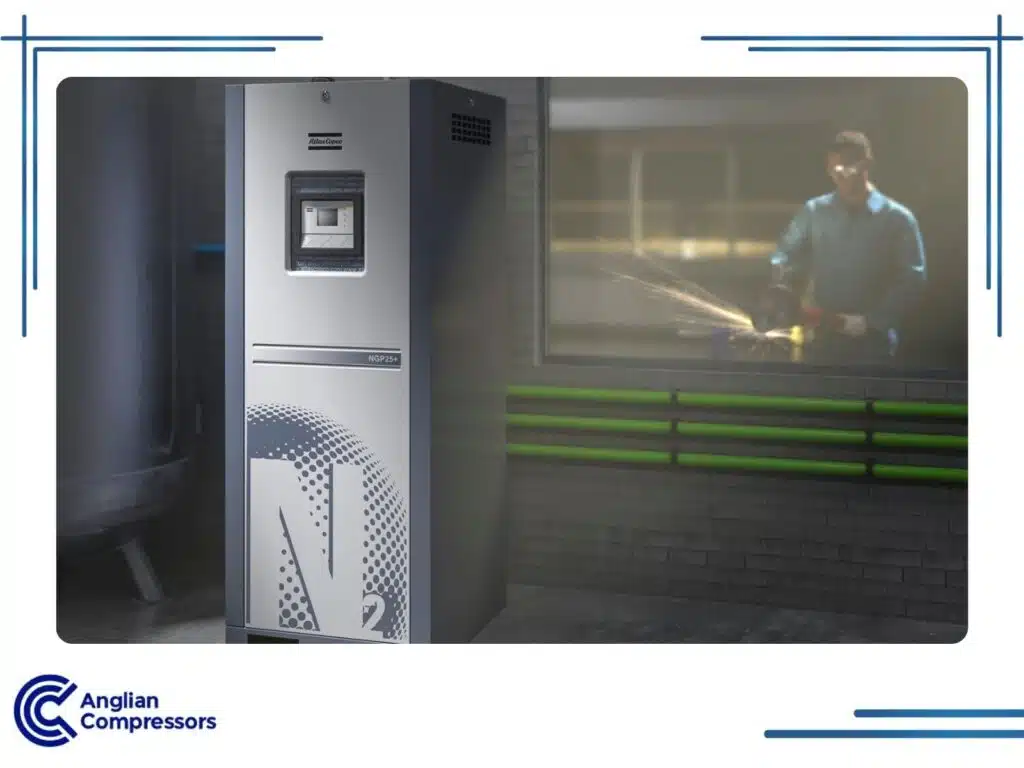How Nitrogen or Oxygen Purity Affect Their Cost
Depending on how much nitrogen you use, installing a gas generator might be cheaper than purchasing gas from a supplier. Purchased gas is guaranteed to be of a very high and specific purity, but if you don’t need this level of purity, you could significantly reduce your operating costs by installing a generator and a compressor. Plus, purity and quality are not the same thing.
In this guide, we explain how purity affects the price of generating gases, such as nitrogen. We discuss the different technologies used to increase the purity of your gas and which environments they’re best suited to. We’ll also help you decide whether to install your own gas generator or purchase gas from a supplier.
At Anglian Compressors, we’ve been installing compressed air systems and gas generators since 1977 for clients in industries ranging from manufacturing and food packaging to healthcare and pharmaceuticals. Please call us if you want to discuss your gas generation or compressed air needs with an experienced specialist.
Nitrogen and Oxygen: Purity vs. Quality
Industrial gas applications often conflate purity with quality. Purity simply measures the percentage of nitrogen or oxygen present, while quality encompasses additional factors like moisture, oil content and particulates in the gas stream – all regulated under ISO 8573-1 standards.
Oxygen-nitrogen separation systems can achieve high purity levels but typically require more energy and bulkier equipment, including air dryers. This added expense isn’t always justified.
For many common applications, purity levels between 95-99.5% are perfectly adequate. These levels are widely used in food packaging and tank blanketing operations where low oxygen levels are more critical than absolute purity.
PSA and membrane systems deliver these purity levels while consuming less electricity. These systems generally offer better energy efficiency compared to systems that maintain higher purity levels.
Match your gas purity to your actual requirements. This practical approach reduces capital costs and supports energy efficiency whilst still meeting industry standards.
Purchased Gas vs. Onsite Gas Generation
In many situations, generating your own nitrogen can be more cost-effective than buying it from industrial gas companies. While onsite gas generation requires an upfront investment, you can make a return on investment through reduced energy costs in as little as six months.
For example, businesses requiring 95–97% nitrogen purity often see the quickest ROI due to reduced equipment costs and lower energy consumption.
Even if it takes a few years to realise cost savings, now might be a good time to invest in a gas generator with an air compressor, in light of fuel and energy costs.
Factors that Affect the Cost of Purchased Oxygen and Nitrogen
The cost of buying nitrogen or oxygen from a supplier extends beyond the gas itself. Transport and delivery charges increase the total, particularly for large volumes. Storing cylinders or bulk tanks requires space and facilities that comply with health and safety regulations.
Environmental levies, energy usage and fluctuating energy prices can further increase overall costs. Stock management, rental fees, and delivery coordination add to both workload and expenses, especially for operations that use nitrogen continuously.
Purity percentage typically doesn’t significantly affect the price of bottled gas. Most suppliers use cryogenic production methods that deliver high purities as standard. This means you might pay for higher oxygen or nitrogen content than your process needs.
For processes without strict purity requirements, on-site generation with an oxygen or nitrogen generator offers a more economical option. This approach provides better control over gas flow, reduces dependence on deliveries, and allows for production to match actual needs, resulting in savings in space, time, and operating costs.

What Impacts the Price of Onsite Oxygen and Nitrogen Generation?
The primary factor that impacts the price of onsite gas generation is the technology that the generator uses. Here’s a quick breakdown of the two most common technologies: pressure swing adsorption (PSA) and membrane technology.
Pressure Swing Adsorption (PSA)
This method involves passing compressed air through molecular sieves, resulting in nitrogen purity levels of up to 99.999% and oxygen purity levels of up to 95%.
Best suited for industries requiring ultra-high-purity nitrogen, such as electronics and pharmaceuticals.
Membrane Technology
Compressed air is directed through semi-permeable membranes, which results in nitrogen purity levels ranging from 95% to 99.5%.
Ideal for applications such as food packaging and blanketing processes. Each technology has distinct operating costs; higher purity levels demand more energy and larger generators, significantly increasing operational expenses.
When it comes to onsite generators, even seemingly minor variations in purity levels, like 99.9% and 99.999%, can have substantial cost implications. Firstly, there are the initial investment costs, such as the purchase of a gas generator, a compressor for feed air, and the necessary air treatment equipment, and storage tanks. Secondly, there are operating costs such as electricity and maintenance.
How Gas Purity Impacts Price
The purer your nitrogen requirements, the bigger the gas generator you’ll need to achieve a given flow rate. Moreover, the larger your generator, the more electricity and compressed air you’ll use and the higher your maintenance costs will be.
For example, a system that generates nitrogen with a purity of 95% might use two cubic feet per minute (SCFM) of compressed air to produce one SCFM of nitrogen. However, a system that generates nitrogen with a purity of 99.999% might use 12 SCFM of compressed air to produce one SCFM of nitrogen.
That means it can take six times the energy to produce nitrogen with a purity of 99.999% instead of 95%, but such a high purity is often unnecessary.
By adjusting gas purity levels to meet specific application needs, companies producing their own gas can reduce their costs in several ways. Namely, purchasing a small generator and compressor could reduce your initial investment costs. This, in turn, could lead to lower operating costs by reducing your energy consumption and carbon footprint.
By tailoring gas purity levels to your application, you can save significantly by minimising equipment size and energy consumption.
What Nitrogen Purity Levels Do I Need?
Here are some general nitrogen purity recommendations for different industries (please keep in mind that the following guidelines are for comparison purposes only):
- Preventing Hazardous Conditions (Blanketing): Typically, 95-97% purity is suitable for most applications.
- Blanketing Edible Vegetable Oils: Aim for approximately 99.9% purity.
- Food Packaging: Around 99.5% purity is sufficient for most applications.
- Printed Circuit Boards: Required 99.999% purity to ensure a good solder joint.
- Heat Treating Metals: Depending on the materials and treatment method, purity can range from 97% to 99.999% (10 PPM of O2).
Understanding your purity requirements can prevent overspending on oversized systems while optimising operational efficiency.
In many industrial settings, nitrogen generation systems are more powerful or pure than necessary. Suppose clients are unsure of what purity levels are sufficient for their processes. In that case, they’re likely to err on the side of caution and specify a higher nitrogen purity level than necessary, particularly if they believe that purity translates to quality.
However, by determining what purity levels you require and specifying your gas generator needs accordingly, you can save a significant sum on running costs.
Learn More about Onsite Gas Generation from the Air Compressor Experts
Should I invest in onsite gas generation to reduce the price of nitrogen or oxygen at your industrial facility? Get in touch with our air compressor specialists, and we’ll gladly lend a helping hand.
At Anglian Air Compressors, we’ve been at the forefront of our industry for nearly five decades. Thanks to our expertise, we can help you determine your gas purity level requirements and select the most suitable system for your specific applications.
Call us today for product information, advice or a no-obligation quote.
FAQ
What are the advantages and disadvantages of producing nitrogen or oxygen onsite?
Producing gas onsite using PSA technology or membrane separation offers a cost-effective, energy-efficient solution for many industrial applications. These systems typically have a small footprint and can be tailored to required nitrogen ratios or oxygen concentrations. However, they need regular maintenance and careful sizing based on the application. Initial investment and membrane performance vary according to gas quality and volume requirements.
How do membrane and pressure swing adsorption systems differ?
Membrane systems separate gases through permeation, allowing some molecules to pass through a membrane faster than others. These suit applications needing moderate purity levels with lower energy use. PSA technology uses adsorbent materials to trap specific gases under pressure, then releases them during desorption. PSA systems achieve higher purities and are often preferred where oxygen content or nitrogen flow must be precisely controlled.
Is gas purity always the most important factor in industrial use?
Not necessarily. While gas must meet basic quality standards, the required purity depends on the application. In industrial processes such as biomethane upgrading or nitrogen blanketing, achieving the right balance between purity and cost is essential. Over-specifying purity leads to higher energy use and unnecessary operational costs when the application doesn’t demand it.


